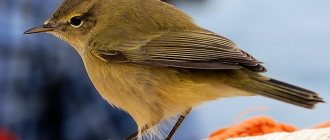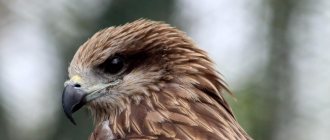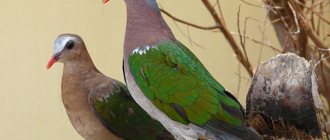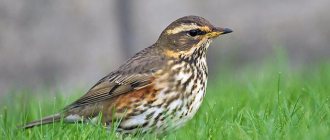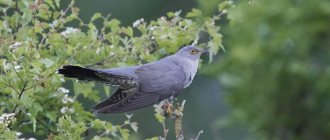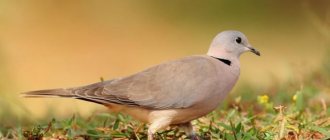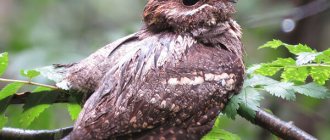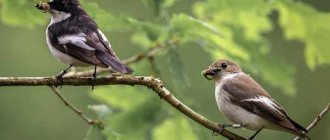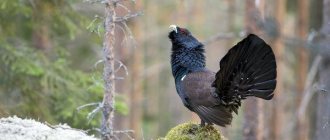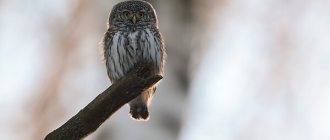The chiffchaff (lat. Phylloscopus Collybita) is another representative of the warbler family. In total, the warbler genus includes more than 50 subspecies of birds with similar colors. They were first described by zoologist Heinrich Boye.
photo: Chiffchaff
The color of the warbler is not bright, the bird has rounded wings and a short straight tail. The length of the body is up to 12 cm, the weight of the bird is 6-8 grams. The back and tail are grayish-brown, with a slight olive tint. The belly is whitish, with a slight yellowish tint, the sides and throat are also yellowish-brown. There is a short light stripe above the eyes. The beak is dark, sharp, the paws are dark. Before flying south, the birds molt completely. The color of young individuals is brown; only 10-12 weeks after the change of plumage do the young acquire adult plumage.
Features and habitat of the warbler bird
Looking at the photo of the warbler, and not understanding birds very well, it can be confused with a sparrow. The length of its body from head to tail reaches 13 cm. The wingspan is about 18 cm. And the weight is 8-9 grams. The color of the bird is dominated by an olive tone.
There are yellow arrow-shaped stripes on the chest, throat and eyes. Some warblers add gray and green to these colors. It is impossible to distinguish a female from a male by appearance. The bird's tail is of medium length, and its beak is thin and shield-shaped. Both the beak and legs are dark in color.
A special feature of these birds is that when preparing to fly to warmer regions, they completely molt, becoming simply brown, like their young, and only after three months their plumage takes on the appearance of adult birds, with olive tones.
Coniferous and mixed forests of Europe and Asia are the favorite place of these birds. This is where they build their nests. In winter, they fly to the African continent and the countries of the Mediterranean Sea. They like the terrain in meadows, near forest edges and clearings most of all.
There are subspecies among warblers that differ from each other in one way or another. Chiffchaff , for example, differs from all its other relatives in the sounds of its songs.
Listen to the Chiffchaff
Pictured is a chiffchaff
If you listen carefully to them, you can understand that they resemble the sounds of falling drops. Its hut-shaped nest can be found on the ground or on a small hill. For the willow warbler, all corners of Europe are the most beloved and native place.
But she cannot winter in those places, so she flies for this time to the warm countries of Africa, located not far from the Sahara Desert. This bird prefers the outskirts of forests, forest edges and bushes. The willow warbler does not like dense thickets. It has been noticed that she sings more than all her relatives.
Listen to the voice of the warbler bird
Its trill can be heard even in bad weather conditions. Her repertoire includes about ten types of different songs, smoothly transitioning into each other. This trill is mysterious and unique.
Pictured is a willow warbler
The rattle warbler has its own original singing, which cannot be confused with anyone else. Its trill consists of a small number of sounds, to some extent they resemble crackling, which accelerates and merges towards the end.
Listen to the voice of the warbler rattle
In addition to this trill, the warbler has a whistling call, consisting of one note “tu” and evokes some melancholy.
In the photo there is a warbler bird
The singing of the green warbler is significantly different from all the others. The sounds of “ti-psuti-psitu-psi-ti-ti-psi” with high notes at the end delight witnesses of the singing.
Listen to the voice of the green warbler
In the photo there is a green warbler
The Warbler is the smallest bird of this genus. Its size is no larger than a king. The singing, alternating between high and low notes, is similar to the singing of a hazel grouse. It is dominated by whistle signals with the whistling sounds “tsivi”, “sisivi”, “tsivit”.
Listen to the singing of the Warbler
In the photo the Warbler
Differences between other types of warblers
The common warbler weighs 10 g, its body is 12-13 cm in length. The plumage changes from greenish-gray above to off-white below. It is distinguished by white legs, a protruding flight feather and a melodic whistle. Its habitats are Brunei, China, Mexico, Russia.
The body of the Warbler is 10 cm in length, but it weighs only 4-9 g. The wingspan is about 16 cm. The color of the plumage is brownish-green on top, a white-yellow belly, white eyebrows and white stripes on the wings and head, a reddish tint to the legs . Habitat: dense forests of eastern Asia.
The brown warbler can be found in the mountain forests of East Asia. She has brownish-reddish plumage, darker on the back and chest, the legs are also dark, and the belly is dirty white. The body length is 14 cm. The bird's beak is short. Makes sharp sounds similar to “check-check”.
The brown-cheeked warbler's cheeks are reddish-brown. Its back is greenish-gray, its belly is white, and its paws are dark. Body length 11 cm, lives in central Africa.
Laura's Warbler is named after the wife of an ornithologist named Boulton. She discovered it in the tropics of Africa.
Character and lifestyle of the warbler
Basically, warblers try to form their pairs and stick to them. Often these pairs join others, forming small flocks. It’s rare, but you can still find these birds in splendid isolation.
It cannot be said that these birds are very cautious. Without much fear, they can let anyone get close to them. They spend most of their time searching for food.
They are distinguished by increased mobility and agility. Their dexterity in moving around a tree is enviable. From time to time they can fly away from the crown of a tree in order to catch an insect. They fly quickly and undulatingly. The warbler's voice is exactly what attracts everyone to her. Once heard, it is impossible to forget.
In the photo there is a warbler bird and chicks
For self-preservation purposes, the warbler's nest is well camouflaged. Most often, the bird builds it not far from the stumps, finding a small depression in the ground, and covers it with dry grass for greater safety. In all species of warblers, the nest has a spherical shape, resembling a hut in its entire appearance. An interesting feature of their nests is the entrance. It is located on the side of the structure.
As soon as the first autumn cold sets in, many species of warblers begin to gather in warmer regions. They return back in August, and some stay until November. During the mating season, the male starts a long and beautiful song in order to attract the attention of the female he likes.
The photo shows a warbler's nest
The warbler gradually gets used to captivity. Initially, she may behave restlessly. Throwing around the cage, inappropriate behavior, and anxiety can be slightly reduced if you cover the cage with the bird with some fabric, thus protecting the bird from the outside world, which seems threatening to it.
Over time, she gets used to the person, calms down and gets used to it. After a period of adaptation, you can even periodically pamper her, let her out of the cage, and give her the opportunity to stretch her wings while flying in open space. The description of the warbler can go on forever. Despite the fact that this is a tiny bird, it is interesting and unique.
Captivity
Warblers take a long time to get used to captivity. The birds behave anxiously, feel restless, and rush around the cage. You can calm the birds a little by just covering the cage with a cloth. The adaptation period is individual for each individual. In any case, after some time the bird gets used to the person, calms down, and begins to sing.
According to reviews, the birds tolerate life in captivity quite well and delight humans with their singing. But they say that you need to be very careful about feeding. Otherwise, the birds gain excess weight and stop singing. Suitable food for insectivores can be purchased in specialized stores.
Nutrition
Small insects are the favorite delicacy of these birds. They love flies, butterflies, ants, mosquitoes and spiders. With great pleasure they eat ripe currants, blueberries, raspberries, and elderberries.
Reproduction and lifespan of the warbler
Male warblers are very caring. They are the first to arrive at the nesting site, find a suitable place for the nest and protect this territory from other birds. After the pair has formed, the female begins to improve their home.
How quickly the nest is built depends on weather conditions. The male's singing can be clearly heard before the nesting period. As soon as this process begins, the intensity of singing decreases. At this time, the male is busy guarding his mate.
In early May, the female lays eggs. As a rule, there are usually from 4 to 8. In European countries, warblers make two such clutches per season. After two weeks, beautiful chicks are born, which fly out of the nest within 14 days. Warblers mature and are ready to bear children within a year of birth. Their lifespan in general is about 12 years.
Interesting facts about chiffchaffs
- The birds got their name from their characteristic singing: they make the sounds “shadow-shadow-shadow”;
- These are one of the few warblers that love coniferous forests; they build nests in the thick of spruce crowns, not high from the ground;
- Chiffchaffs are also called grasshopper warblers;
- During the nesting period, the female is responsible for building the nest and incubating it, while the responsibilities of the males are protecting the territory and providing food;
- Defending the nest, small chiffchaffs attack even large predators - stoats, weasels or jays.
